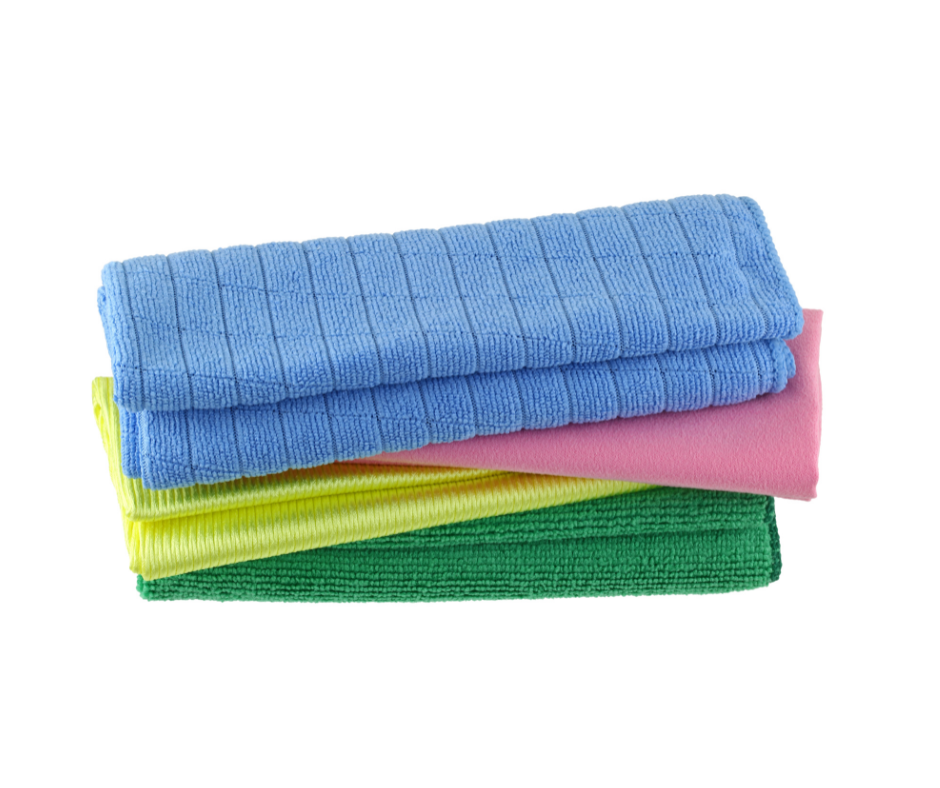FREE NATIONWIDE SHIPPING ON ORDERS $69 AND OVER
FREE NATIONWIDE SHIPPING ON ORDERS $69 AND OVER
Add description, images, menus and links to your mega menu
A column with no settings can be used as a spacer
Link to your collections, sales and even external links
Add up to five columns
Add description, images, menus and links to your mega menu
A column with no settings can be used as a spacer
Link to your collections, sales and even external links
Add up to five columns

Microfiber Cloths are they Green and what about the Alternatives.
February 05, 2024 3 min read
In this blog, we look at this really murky pool of information about microfiber, its Positives, Negatives, the alternatives, and how green those alternatives are.
When I say murky, I really mean really murky. You can find a bunch of info saying how bad microfibre is, written by companies that promote/ sell alternatives, and then when one starts digging into the alternatives, you learn that they are not so squeaky clean either.
We have tried to keep this as simple as possible so we can make comparisons without making light of the issues all of the options have. We don't sell any cleaning cloths but recommend microfibre because they are scientifically proven to provide the best cleaning of any cloth on the market today.
All of the options have compromises - it's up to the individual to decide what aligns with their individual values.
Microfibre cloths.
Negatives -
- They shed Microfibre when washed.
- They are made from Polyester and polyamide. ( nylon)
- Polyester is a synthetic material made from Petroleum.
- They are not biodegradable.
- You can capture the line or microfibres but then what do you do with them? - rubbish bin to landfill.
Positives
- They are strong and long-lasting, able to be reused over and over again.
- They are incredibly effective at cleaning. Being positively charged they attract dirty grime and germs which have a negative charge. They become even more effective when they are used in conjunction with cleaning products like Cleanz which contain glucosides. Glucosides lift dirt and germs off surfaces and hold them in suspension to be removed by a cloth and washed down the drain.
- It has been reported that microfibre cloths actually reduced hospital infection rates. Journal of Hospital Infection https://www.sciencedirect.com/science/article/abs/pii/S0195670111001101
- Test showed that they become more effective after 75 washes and begin to be less effective after 150 washes ( washing machine washes )
- Initial studies in the US indicate that 95%–99% of microfibers are captured in the types of municipal wastewater treatment systems common in the US. (Studies have not been undertaken in New Zealand.)
- The release of microfibres into the environment can be mitigated by either having a front load washing machine that has lint filters or placing all of your polyester/synthetic items into a Guppy Bag when washing. This will capture all of the lint. But then what?
Cotton Cloths
Negatives
- Water use - Cotton is very water intensive. Unfortunately, it is a statistic that is jumped on by anyone wanting to promote alternatives. We have seen in some blogs that water usage is over 20,000 liters to make one tee shirt. Seems unlikely to us. We found a study by the University of Florida that set the usage at 2700 litres to make a tee shirt which is still an awful lot but somewhat less the some would have us believe.
- High use of Synthetic fertilizers used in the growing of cotton. These have a tendency to be washed into rivers streams and aquifers, causing much environmental damage.
- Processing. About 8,000 synthetic chemicals are used to turn raw materials into textiles and around 20% of industrial water pollution globally comes from the treatment and dyeing of textiles. These chemicals contaminate the billions of liters of water used to process textiles and then are discharged into waterways.
- Cotton doesn't actually lift dirt and germs from surfaces so you are relying solely on the chemicals in the cleaning product to kill the germs and bacteria.
Positives
- Biodegradable, Cotton microfibres break down
- Re-purpose You can re-purpose older clothing into cloths
- Re-use - you can put them through the wash.
Bamboo Cloths
Negatives
- Bamboo is mechanically crushed to extract the cellulose, which is then processed into Viscose/ Rayon. The processing of this involves chemicals that on a lot of processing facilities capture in closed-loop systems. This is Good - BUT - Unfortunately, the process also produces Carbon Disulfide, which when inhaled is very harmful. Workers are seriously harmed by inhaling the carbon disulfide (CS2) used to make bamboo viscose. Effects include psychosis, heart attacks, liver damage, and blindness. Rayon factories rarely give information on their occupational exposure limits and compliance. Even in developed countries, safety laws are too lax to prevent harm
- These are also not positively charged so are not shown to lift dirt and germs from a surface so you are reliant on the cleaning solution to kill the germs and bacteria. ( see our blog on Why we need to stop disinfecting our homes)
- Not as reusable as Microfibre cloths - and are able to be washed a few times only.
Positives
- Made from a renewable and fast-growing source.
- Biodegradable - Bamboo cloths and the microfibres breakdown.
- Re-useable – they are reusable - you will get a few washes out of them.
In Summary - none of them are clean and green, at the end of the day its a personal choice.
What's the saying "Choose your Poison"
Leave a comment
Comments will be approved before showing up.
